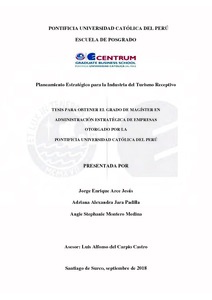| dc.contributor.advisor | Carpio Castro, Luis Alfonso del | |
| dc.contributor.author | Arce Jesús, Jorge Enrique | es_ES |
| dc.contributor.author | Jara Padilla, Adriana Alexandra | es_ES |
| dc.contributor.author | Montero Medina, Angie Stephanie | es_ES |
| dc.date.accessioned | 2018-09-20T20:26:43Z | |
| dc.date.available | 2018-09-20T20:26:43Z | |
| dc.date.created | 2018 | |
| dc.date.issued | 2018-09-20 | |
| dc.identifier.uri | http://hdl.handle.net/20.500.12404/12678 | |
| dc.description.abstract | La industria del turismo en el ámbito mundial contribuyó en el 2017 con US$8.3
billones (10.4% del producto bruto interno global) y generó 313 millones de empleos, que
equivale a uno de cada 10 empleos en el planeta, además las llegadas internacionales
ascendieron a 1,323 millones (18% del total de habitantes en el mundo). En Perú, el turismo
receptivo contribuyó con US$4,573 millones y generó 1.3 millones de empleo en el mismo
periodo (7.4% de la población económicamente activa), además la llegada de turistas ha
ascendido a 4 millones con un crecimiento promedio de 7.2% en los últimos cinco años.
Respecto al mundo, Perú capta el 0.3% de turistas internacionales, lo que demuestra una
oportunidad para crecer en participación de mercado y por tanto, mejorar la oferta para atraer
mayor número de turistas internacionales. Machu Picchu recibió un millón de turistas en el
2017, en tanto Chichén Itzá (México) y la Torre Eiffel (Francia) fueron visitadas por 2 y 7
millones de turistas respectivamente; cifras que refuerzan la oportunidad de ganar
participación mediante mayor número de turistas. Se identificó a EE. UU., China, y Brasil
como los principales países emisores de turistas al Perú, considerando el gasto promedio
(mayor a US$1,000) y el número de turistas de estos tres países que visita el mundo.
El Perú tiene grandes reconocimientos en el ámbito mundial como: mejor destino
culinario del mundo, mejor destino cultural, destino top mundial, patrimonio mundial de la
UNESCO, entre otros; destacando como país biodiverso a escala cultural, de recursos
naturales y gastronomía, es decir una fortaleza para aprovechar ante las oportunidades y
amenazas del país. Además, a través de la integración de clústeres nacionales, una mayor
inversión pública, privada, y de asociaciones público-privadas (APP), acompañados de
estrategias para desarrollar, potenciar, y mejorar los productos turísticos e incrementar la
participación de mercado; se espera que esta industria duplique sus ingresos, el empleo, la
inversión anual pública, privada, y mixta en los próximos 10 años. | es_ES |
| dc.description.abstract | The tourism industry worldwide contributed in 2017 with US$8.3 trillion (10.4% of
the global GDP) and generated 313 million jobs, equivalent to one in 10 jobs on the planet,
furthermore, international arrivals closed at 1,323 million in 2017 (18% of the total
population in the world). In Peru, incoming tourism contributed US$4,573 million and
generated 1.3 million jobs in 2017 (7.4% of the economically active population), in addition,
the arrival of tourists has amounted to 4 million with an average growth of 7.2% in the last
five years. Peru received 0.3% of international tourists, which shows an opportunity to grow
in market share and therefore improve the offer to attract a greater number of international
tourists. Machu Picchu received one million tourists in 2017, while Chichén Itzá (Mexico)
and the Eiffel Tower (France) were visited by 2 and 7 million tourists, respectively; figures
that reinforce the opportunity to gain participation through a greater number of tourists. The
United States, China, and Brazil were identified as the main countries that send tourists to
Peru, taking into account the average spending (more than US$1,000) and the number of
tourists from these three countries that visit the world.
Peru has great worldwide recognition as: best culinary destination in the world, best
cultural destination, world top destination, UNESCO world heritage, among others;
highlighting as a biodiverse country on a cultural scale, natural resources and gastronomy,
that is, a strength to take advantage of our opportunities and threats. In addition, through the
integration of national clusters, greater public and private investment and public-private
partnerships (PPP), accompanied by strategies to develop, enhance and improve tourism
products and increase market share; it is expected that this industry will double its income,
employment, annual public, private, and mixed investment in the next 10 years. | es_ES |
| dc.language.iso | spa | es_ES |
| dc.publisher | Pontificia Universidad Católica del Perú | es_ES |
| dc.rights | info:eu-repo/semantics/openAccess | es_ES |
| dc.rights.uri | http://creativecommons.org/licenses/by-nc-nd/2.5/pe/ | * |
| dc.subject | Turismo--Perú | es_ES |
| dc.subject | Planificación estratégica | es_ES |
| dc.title | Planeamiento estratégico para la industria del turismo receptivo | es_ES |
| dc.type | info:eu-repo/semantics/masterThesis | es_ES |
| thesis.degree.name | Maestro en Administración Estratégica de Empresas | es_ES |
| thesis.degree.level | Maestría | es_ES |
| thesis.degree.grantor | Pontificia Universidad Católica del Perú. CENTRUM | es_ES |
| thesis.degree.discipline | Administración Estratégica de Empresas | es_ES |
| renati.discipline | 413307 | es_ES |
| renati.level | https://purl.org/pe-repo/renati/level#maestro | es_ES |
| renati.type | https://purl.org/pe-repo/renati/type#tesis | es_ES |
| dc.publisher.country | PE | es_ES |
| dc.subject.ocde | https://purl.org/pe-repo/ocde/ford#5.02.04 | es_ES |






